Somewhere, in between the volcanic needles of Nimbin Rocks and the soft round shadows cast by Lillian Rock, the self-anointed freaks are gathering again.
Fifty years ago, they were mainly middle-class uni students, sometimes stoned, often naked, who descended on a psychedelic jamboree known as the Aquarius Festival in Nimbin.
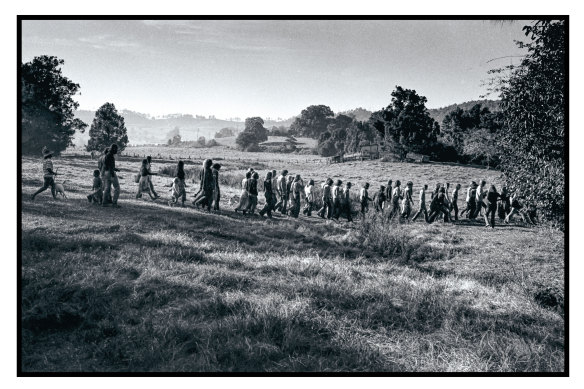
Festival leader Paul Joseph strolled through the campsite every morning with his guitar, singing a song by the Incredible String Band, as followers in a conga line chanted the lyrics: May the long time sun shine upon you, All love surround you, And the pure light within you, Guide your way home.
Credit:Peter Derrett
A gob-smacked nation watched these aspiring hippies excitedly manifest manifestos on the nightly evening news, even prime minister Gough Whitlam was called on in parliament to explain what was going on, especially since his government had given $50,000 to help stage the event.
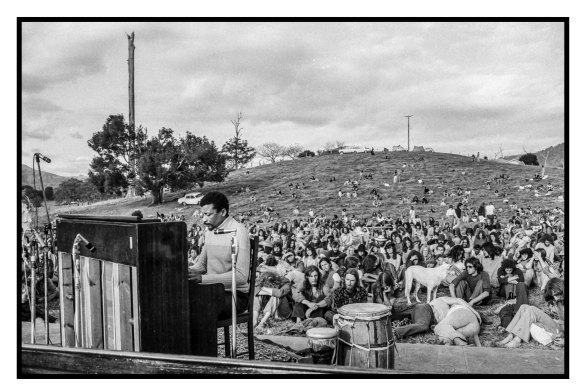
South African pianist Dollar Brand (later known as Abdullah Ibrahim) plays at the 1973 Aquarius Festival in Nimbin.Credit:Peter Derrett
Now, suddenly, these revellers are in their 70s and 80s. Which is to be expected for most of us, but it’s probably a shock for them, when time was supposed to be, in fact, on their side.
Even with mortality nudging, however, the aged of Aquarius still have the brass neck to demand our attention, with their 50th-anniversary celebrations kicking off on Friday.
The 10-day festival has a remarkable legacy; activists who fought to save Australia’s rainforests and the Franklin River; a message of walking lightly on the earth, and architecture sympathetic to the environment. It helped introduce mainstream Australia to alternative medicine and wellness, while establishing Nimbin as the base for the campaign to decriminalise marijuana, which has elected representatives to parliaments across Australia.
Who were these people, what was it like and, finally, how did Doug Anthony, the Country Party and Nationals legendary hard man, decked out in a safari suit, end up in the middle of all this nudity and pot smoking?
The answers are difficult to obtain, as the late English writer Jenny Diski, a renowned counterculture commentator, once wryly observed, memory is “excitingly corrupt in its inclination to make a proper story of the past”.
Diski would have been fascinated by Nimbin, a bumpy, crooked snake of psychedelic shops, cafes and municipal buildings, that is now the alternative lifestyle capital of Australia. Fact and fiction stopped occupying separate rooms in this community long ago, so perhaps it’s best to go back to the very beginning to get closer to some form of truth.
One of the festival’s original driving forces, Johnny Allen, eases back on his chaise lounge in a well-appointed Elizabeth Bay apartment in the weeks before the anniversary celebrations. Life on a hippie commune was never really his go. His once-long hair is closely cropped and a walking stick sits ready, if needed, against the nearby door frame.
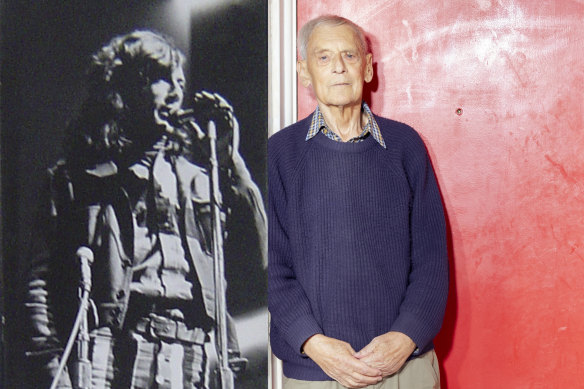
Then and now: Aquarius Festival director Johnny Allen while on the Aquarius Foundation touring circuit and a current picture of Allen at his home in Elizabeth Bay, Sydney in 2023.
He has a calm manner that allows him to float above any conversation and navigate any pitfalls – a handy attribute for any promoter, let alone one running chaotic Aquarius, which famously chose to operate without a program.
He says Australia in the early 1970s was emerging from a time of great turmoil, riven by conscription during the Vietnam War and attempts by anti-apartheid protesters to stop the 1971 South African rugby union tour. Attitudes towards women and First Australians were changing. Labor prime minister Gough Whitlam had just been elected after 23 years of Coalition government.
The young adults wanted to do something big, something that spoke to a desire to leave behind “the social ills they … rejected — materialism, consumerism, war, pollution, and the threat of ecological doom — to try to fulfil the positive ideals that [had] … arisen in their place — self-sufficiency, creativity and love”.
In 1972, Allen and Graeme Dunstan (who nicknamed themselves Kaptain Kulture and Superfest) were employed by the Aquarius Foundation, the cultural wing of the Australian Union of Students and were looking for a new site to stage a bi-annual festival to match these desires.
Instead of an Australian version of the US music festival Woodstock, they wanted to put on a giant alternative lifestyle expo harmonising with the natural environment, with workshops, music, arts and other entertainment. Life as art.
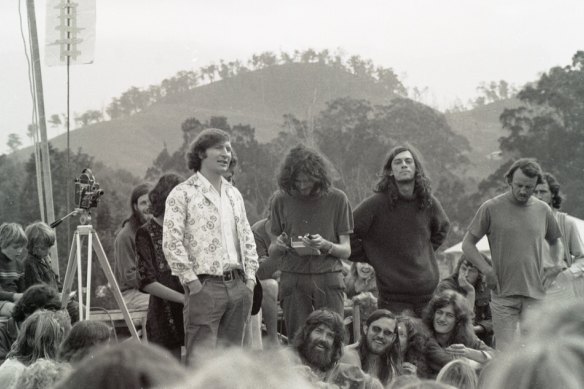
Aquarius Festival director Johnny Allen (second from the right) and AUS president Ken Newcombe (far left) in Nimbin in 1973, following a drug raid when a police hand gun went missing.
They wanted to take the event off campus and back to the country. However, rural towns were reluctant to host the hippies. A dying cow-cocky town called Nimbin, outside Lismore, in northern NSW was suggested.
“The sun was setting as we first drove into the sleepy Nimbin township, which for all the world appeared to be a ghost town,” Allen says.
“An old-timer sat fast asleep in a rocking chair outside an empty shop, while a dog snoozed undisturbed in the middle of the road. A big idea dawned on us – why not recycle a town?”
A town meeting was called to pitch the idea of the festival.
Come the night of the meeting on January 13, 1973, the hall was full, with most of the residents in attendance. Dunstan explained the concept of the festival, and had a trump card: a letter of support ironically from the local police officer, Rob Marsh, who was away on a family matter.
“We have little if anything to lose and certainly nothing to fear from the immensity of this scheme … it is a chance in a lifetime that any other town would quickly snap up, and if the chance is lost, I feel sure that we will live to regret the day,” Marsh wrote.
The town voted unanimously to support the idea.
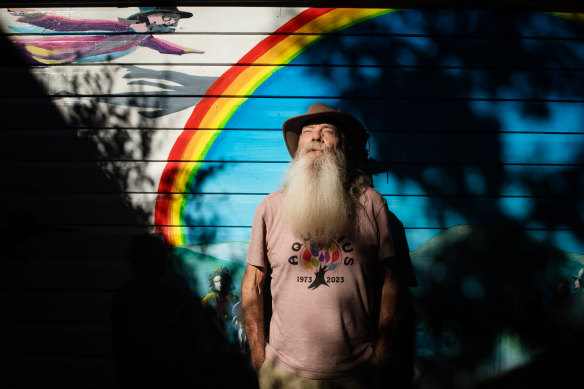
Aquarius Festival director Graeme Dunstan in Nimbin. A political activist, Dunstan has lived in a van for the past 20 years. Credit:Elise Derwin
Allen says the festival was a co-production between the AUS Aquarius Foundation and the town, with the townspeople forming their own entertainment committee that planned to contribute rodeos, carnivals, a longest-beard competition, the annual sports carnival, tug-o-war (the Nimbin team was the Australian champion), and a back-to-Nimbin reunion for early settlers.
However, the scale of the student’s ambitions for their part of the festival was much bigger and truly radical. In the four months leading up to the festival on May 12, 1973, a community of several hundred volunteers converged on Nimbin to help prepare the site.
Vernon Treweeke, an artist known as the father of psychedelic art in Australia, painted the front of the Rainbow Cafe, and eventually murals on most of the shops in the main street. Artist and activist Benny Zable later joined him.
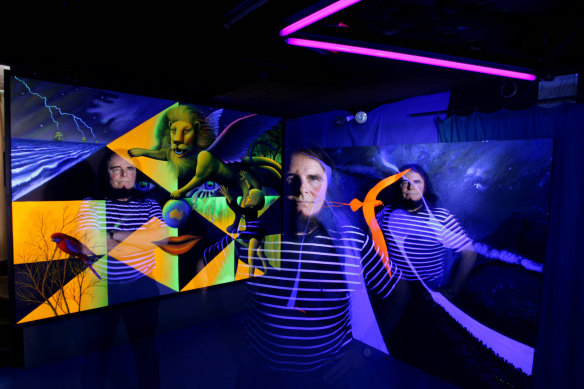
Artist Vernon Treweeke, dubbed the father of psychedelic art in Australia, painted murals along most of the main street of Nimbin, with Benny Zable, for the 1973 festival. Treweeke died in 2015.Credit:Marco Del Grande
Aquarius bought the local RSL hall, painted a bright, upside-down Union Jack on the outside, and turned the hall into a “media factory”, to accommodate the Nimbin Good Times newspaper darkroom, offset printing, typesetting, artwork, screen printing and TV studio.
Two shops in the town were bought by students, one to become a “soup kitchen” and the other to be “The Tomato Sauce Factory” – a food store and arts and crafts centre. Festival production head Vianne Tourle, who bought one of the buildings for “a very small amount”, said she has been thinking lately about how accepting the farming community was of what was a “truly overwhelming” event.
Trains were chartered to transport festival goers from Melbourne and Sydney to nearby Lismore. A doctor-less hospital was restaffed with festival medics. The showground and adjoining land behind the main street were leased, and site systems for toilets, showers and saunas prepared.
Allen says the mixed-sex saunas were a great hit, along with nude swimming, nude sunbathing and just about nude everything else.
Long-time Byron local and former US pro surfer and journalist Rusty Miller, 79, had already started the region’s first alternative newspaper. He was part of the soul surfer movement to the North Coast and attended the festival.
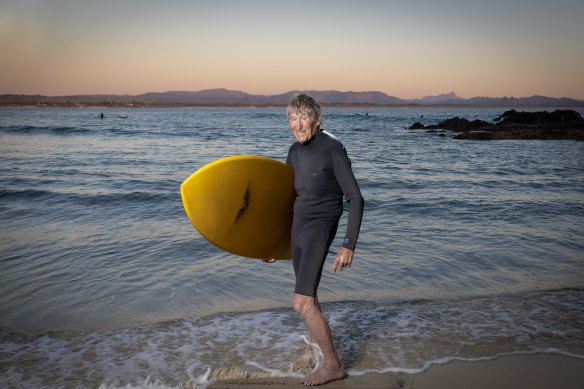
Rusty Miller at The Pass, in Byron Bay. Like Bill Clinton, I didn’t inhale, says Rusty Miller about his week camping at the Aquarius Festival. Credit:Danielle Smith
“Aquarius was an affirmation of everything I believed in,” he says. “I came away invigorated that others, like me, wanted to surround themselves with beauty.
“I had a new language of how to live, with solar energy, good architecture, low-rise buildings and decriminalisation of drugs.”
“Even now I still want to rewild our town, our community, our shire, our nation.”
Mira Stannard, formerly Carole Eliott, 85, a home-birth pioneer, was the unofficial healer of the festival.
“It was the freedom [of the alternative lifestyle movement] that attracted me, make love, not war,” she says.
“It allowed me to be a sort of gypsy and that material things didn’t matter. And the way we did drugs, like acid or mushrooms, was really respectful. It was almost like a sacrament.
“We were kept very busy, right through the festival, treating all kinds of upsets and ailments.
“Darling, I can’t remember some things but, then again, I am an old hippy who took acid.”
In the middle of the kaftans and beads crowd was Doug Anthony, Australia’s longest-serving deputy prime minister, the federal member for Richmond, and renowned hard man of the Country Party and later Nationals.

Deputy Prime Minister Doug Anthony, his wife Margot and son Larry in 1978.Credit:Victor Colin Sumner
Anthony died three years ago. However, his wife Margot, 92, happily recalled the day they visited Aquarius in the station wagon with no seatbelts.
It has gone down in family folklore. They joke that the politician was resolute in shaking hands with naked revellers, looking them firmly in the eye.
“I’m pretty sure Doug was invited out by the residents for one of their events, and he probably did wear a safari suit, although I can’t remember one that was powder blue as some have suggested,” Margot laughs.
Loading
“We took the whole family [sons Dugald and Larry and daughter Jane] thinking that Aquarius would be something interesting. Well, it was certainly that.”
Jane, who was 12 at the time, says her father and mother had no idea what was going on. “Dad had a lovely time,” she said.
Dugald, then 15, was uninterested in the politics of the day, and walked among the tepees.
“I then came upon these naked women swimming, and it was like a Norman Lindsay painting,” he says. “I remember thinking, ‘I don’t know what this is all about, but I love it’.”
Youngest in the family, Larry, aged 11, was transfixed by something else.
His father was giving a speech to a mixed audience of locals and visitors outdoors. High up, behind his father, a man wearing a top hat was crossing a raised wire on a unicycle.
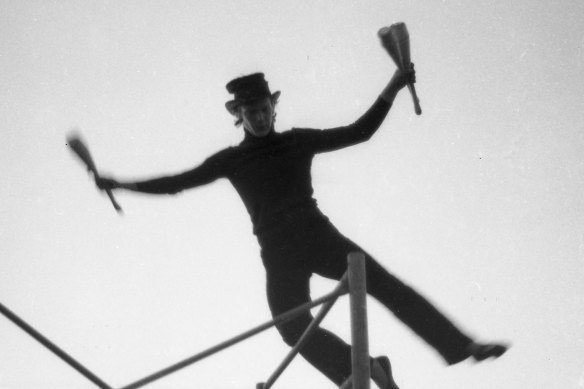
It was Philippe Petit, the man who would walk one year later between the two World Trade Centre buildings in New York on a wire.Credit:Chris Meagher
It was Philippe Petit, the man who would walk one year later between the two World Trade Centre buildings in New York on a wire.
Everyone then piled back into the station wagon for what would have been a long strange trip home, indeed.
The Morning Edition newsletter is our guide to the day’s most important and interesting stories, analysis and insights. Sign up here.
